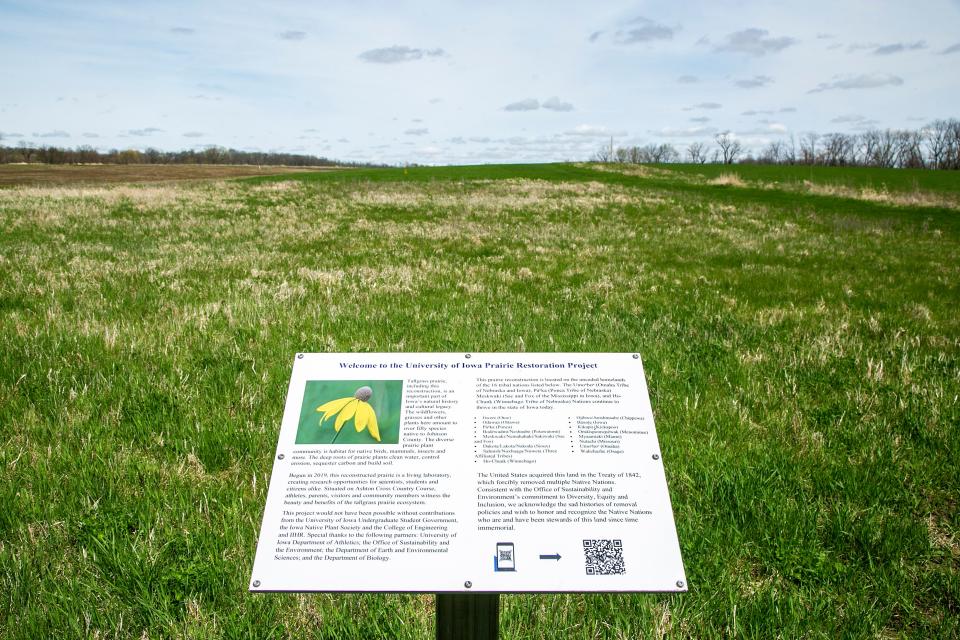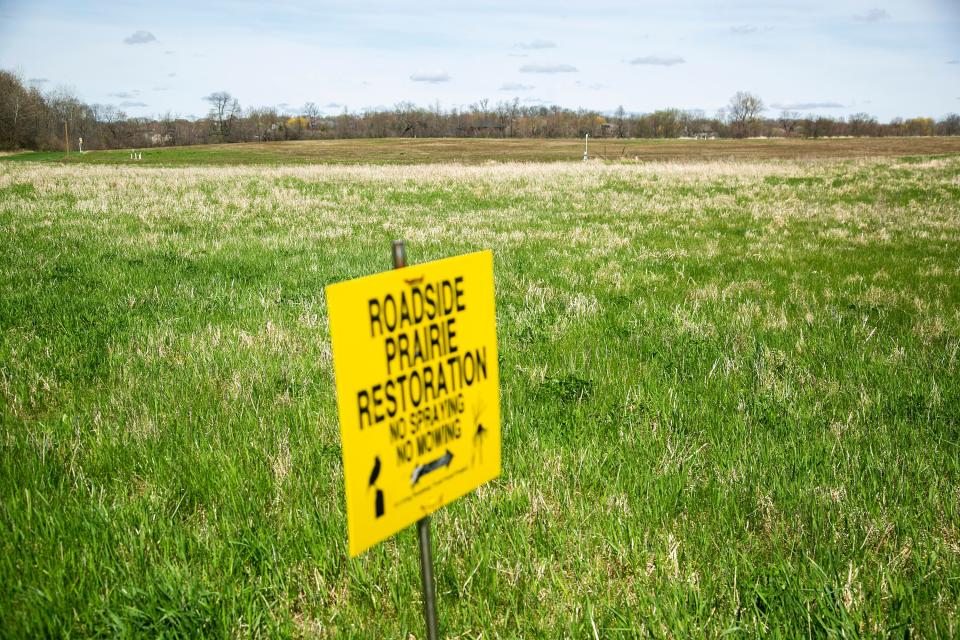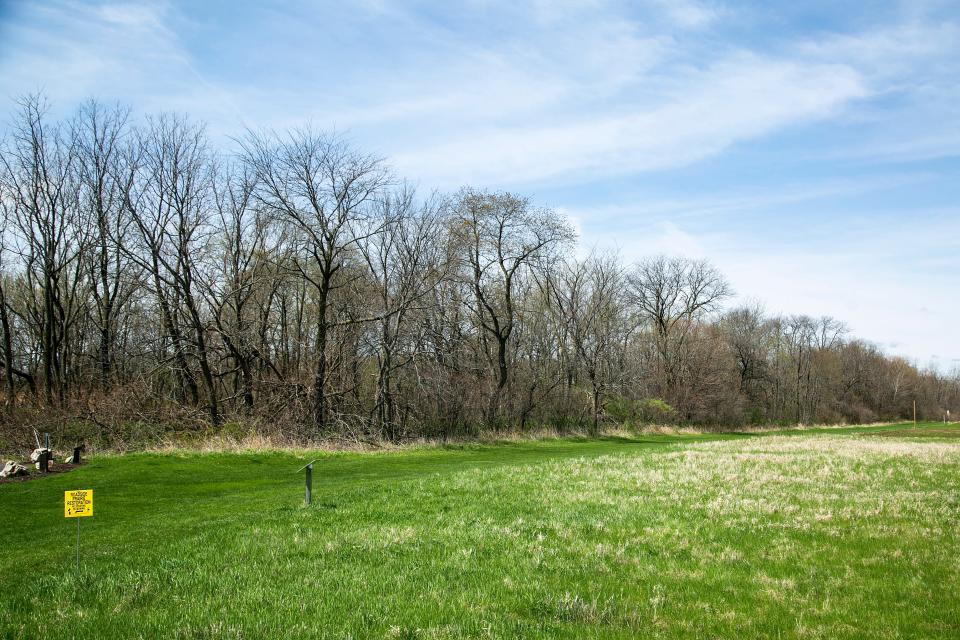The University of Iowa is committed to becoming a 'bee-friendly' campus. Here's how.
After native plants hit the Iowa City soil in 2020, Andrew Forbes was one of many people there to watch in awe as insects came to check them out.
For the University of Iowa evolutionary biologist, it's not just exciting that a growing number of insects are voyaging to UI's Ashton Cross Country Course prairie reconstruction site. He's noticed more "specialist" insects showing up over time, having smelled-out the plants they are meant to feed on from far away.
"A sort of, if you plant it, they will come, sort of thing," said Forbes, who studies insect diversity.
Pesticide use, habitat loss and climate change are driving forces behind the marked decline in pollinator species globally. That presents a problem for economic and environment sustainability — particularly when considering about 35% of food crops globally depend on animal pollinators.

In response, a lengthening list of colleges have committed to taking steps in their favor by becoming a "Bee Campus USA" school. It means they have agreed to create pollinator habitats, like UI's native prairie, reduce pesticide use and support pollinator-focused educational programs.
More UI news: University of Iowa President Barb Wilson unplugged: On state politics, COVID, the value of higher ed
Since 2015, 139 campuses have joined the Xerces Society for Invertebrate Conservation's efforts. As of March, UI is the fourth in Iowa to join, alongside Central College, St. Ambrose University and Luther College.
Council Bluffs and Mount Vernon are part of the sister program for cities, which is 156 strong across the country.
"The end goal is to really incorporate native plants and that type of habitat into plantings all across campus, so that it's not a type of one-off thing where we have a pollinator garden over here. It's really adopting native plants as part of our campus," said Beth MacKenzie, a sustainability program manager in UI's Office of Sustainability and the Environment.
More on education: Iowa City schools spending COVID-19 relief funds to upgrade air flow in health offices
With students' help, UI reducing pesticide use

Katarina O'Kulich read about bee-friendly campuses in her Introduction to Environmental Science textbook last spring. It didn't take long for her to figure out how to help UI get its certification.
O'Kulich's family has had low-flush toilets "since way before it was cool." She grew up in an environment-loving family, but she can't pinpoint when she started focusing on the issue of pollinator decline.
"In my elementary school, I remember when they put in a monarch butterfly garden, because I'm from Illinois and so, (it's the) state butterfly and everything," O'Kulich said. "I just remember noticing over these past few years that you just don't see pollinators as much anymore."
There are an estimated 20,000 species of bees across the world, including about 3,600 native to North America. An estimated 28% of bee species across the U.S., Canada and Mexico are under threat, according to Xerces.
O'Kulich is a member of the recently formed "bee committee" at UI, one of the required components of becoming a Bee Campus USA affiliate. Its members are tasked with making sure the school meets commitments required of all bee campuses.
More on education: What does the history of prestigious AAU membership say about Iowa State's departure?
It's not just putting more native species of plants into the ground and creating bee nest sites. It's also about reducing pesticides.
UI applied about 48 gallons of herbicide, fungicide or insecticide in 2018, according to a 2021 report. Eighty-two percent was used on athletic grounds.
"(Athletics) want to do things more sustainably, but athletics has to maintain a certain image; it has to still look a certain way," O'Kulich said. "So we need to work with them to figure out how we can do both; how we can still have a nice image, have that nice green space and the campus that Iowa is known for, but then be more sustainable about it."
So far, UI has phased out the use of neonicotinoids — a type of insecticide that can show up in pollen and nectar, killing bees. The university is in the process of phasing out their use by third-party vendors through new contract language, said Stratis Giannakouros, UI's sustainability director.
The bee committee will oversee UI's turf and pest management plans, plus related pesticide use on campus.
Xerces also asks schools to weave the topic of pollinator conservation into classes and service learning opportunities, says Laura Rost with the Xerces Society.
Rost said it's important for students across disciplines to understand the need to protect pollinators. Architecture students, for example, could incorporate native plants and pollinator habit into their designs.
"There's all these ways we can integrate pollinator conservation into the non-sciences," Rost said. "I think everyone wants to help, and they just need to know what needs to be done."
More education news: Joseph Brown Sr. leaves interim superintendent role in Clear Creek Amana early for political run

It's true: 'Beautiful' pollinators notice native plant efforts
It's clear that college campuses alone can't solve the pressing problem of pollinator decline. But as Forbes explains scientifically, pollinators do notice when humans intentionally create spaces that protect their well-being.
Putting more plants into the ground — especially native plants — leads to somewhat selfish benefits: more beautiful gardens. It's because the more species of plant in a garden, the greater variety of insects. The more insects, the more predators to ward off pests.
As a result, flowers bloom.
But that's not the only argument for taking small steps to support biodiversity, Forbes said.
"The best reason is just because the insects and the other animals that come in are beautiful themselves; you can kind of play a part in conserving them," he said.
Cleo Krejci covers education for the Iowa City Press-Citizen. You can reach her at ckrejci@press-citizen.com.
This article originally appeared on Iowa City Press-Citizen: University of Iowa joins list of 139 certified bee-friendly campuses

